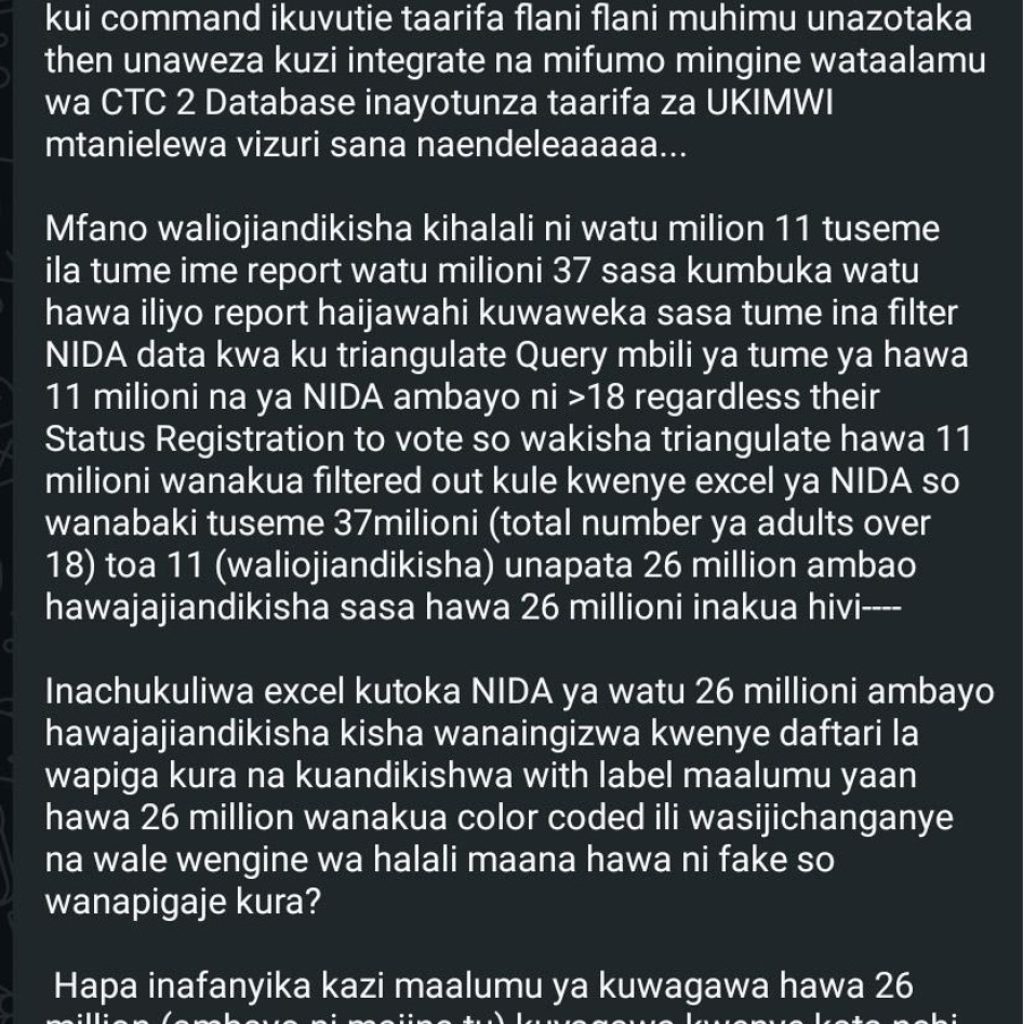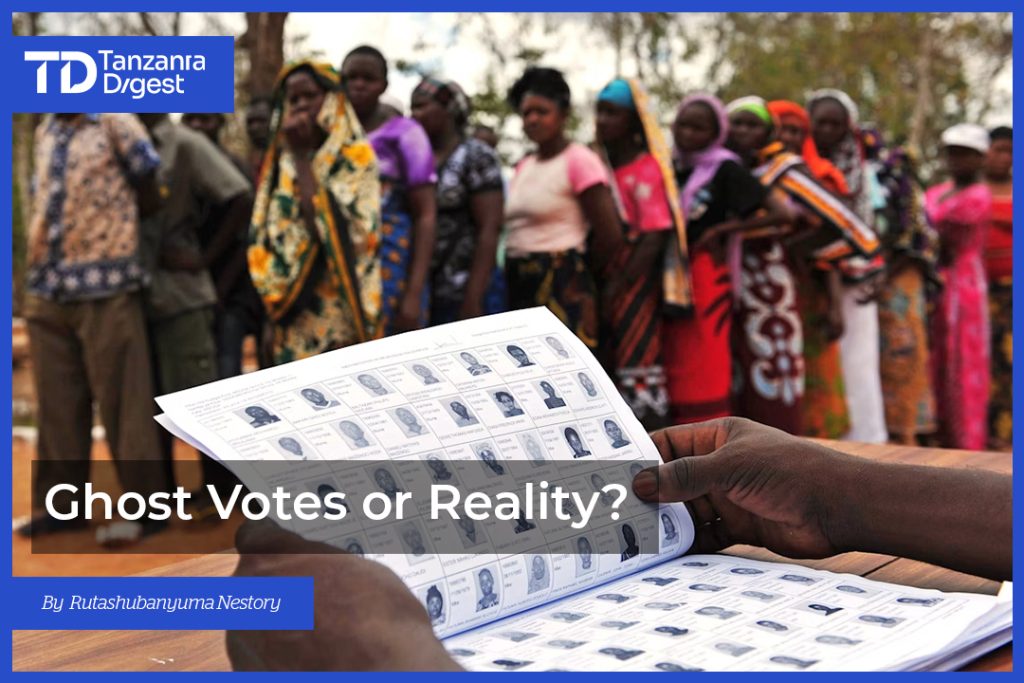There is a chain letter doing massive rounds on social media platforms that raises serious allegations about potential manipulation in Tanzania’s voter registration process for the 2025 general election.
This mysterious whistle-blower alleges the INEC figure of registered voters is fake, and that the registered voters are around 11 million. He goes on to cement his case with the details of how INEC crammed up the 26 million ghost votes for the purposes and intents of flipping CCM to a massive win.
The author claims that Tanzania’s electoral process is susceptible to a sophisticated form of digital manipulation. The core allegation is that the Independent National Electoral Commission (INEC) is using a technique called data triangulation or query integration between its voter database and the National Identification Authority (NIDA) database.
Whistleblower’s Alert: In His Own Words.


From 11 Million to 37 Million: The Mystery of Tanzania’s Voter Register and Allegations of Ghost Voters.
The alleged process is as follows:
1. INEC has lawfully registered 11 million voters.
2. However, INEC has publicly reported a total of 37 million registered voters.
3. The author alleges that the additional 26 million names were obtained by querying the NIDA database for all citizens over 18, regardless of their registration status.
4. These 26 million names are then imported into the voter register and are “color-coded” or labeled as fake to distinguish them from legitimate voters.
5. On election day, pre-marked ballots are allegedly inserted into boxes at polling stations to match the number of these fake voters, thereby inflating the vote count for the ruling party (CCM) and legitimizing what the author calls electoral “theft.”
The author concludes by offering his services as an independent inspector to uncover this alleged scheme.
Exclusive: Allegations of Systemic Voter Roll Manipulation Threaten Tanzania’s 2025 Election Legitimacy.
Analysis of the Allegations in Context:
The author’s claims, while detailed, are serious allegations of electoral fraud. To understand their plausibility, it’s essential to contrast them with official reports and the broader political context as presented in the provided research results.
1. Official Voter Registration Figures.
The official figure from INEC is indeed 37,655,559 registered voters, which marks a 26.55% increase from the 2020 election. INEC attributes this significant increase to a robust voter mobilization campaign and growing civic awareness. The commission has defended this number against public skepticism. INEC’s Director of Elections, Ramadhani Kailima, explained that the figure includes over 3 million eligible citizens who failed to register in the previous two election cycles but have now done so, arguing that the total is consistent with population projections.
2. The Political Context of Mistrust.
The allegations do not exist in a vacuum; they emerge from a highly contentious and repressive pre-election environment. This context is crucial for understanding why such theories gain traction:
Main Opposition Disqualified: The country’s main opposition party, CHADEMA, has been barred from participating in the elections after it refused to sign a mandatory electoral code of conduct as part of its “No Reforms, No Election” campaign.
Crackdown on Dissent: CHADEMA’s leader, Tundu Lissu, has been arrested and charged with treason, which is non-bailable and carries the death penalty. There have been reports of abductions, killings of government critics, and a severe crackdown on media freedom.
Erosion of Democratic Norms: Analyses describe Tanzania as sliding into “electoral authoritarianism,” where elections are held. Still, the process is heavily manipulated in favor of the ruling party, Chama Cha Mapinduzi (CCM). The country was recently categorized as “Not Free” by Freedom House.
Exclusion of Observers: Major international election observer missions, including those from the Southern African Development Community (SADC) and the East African Community (EAC), have been excluded from the polls, reducing transparency. It appears that the issue with Kenyan observers is the real reason behind this decision.
It is imperative to note that since the reintroduction of multiparty democracy in 1992, SADC and EAC observers have been part and parcel of legitimizing electoral malpractices in Tanzania. Now, even they can no longer be trusted to perpetuate electoral injustices in Tanzania. It thoroughly narrates why their participation is now considered expendable!
Times have changed significantly following Tundu Lissu’s treason case, and the caustic “hairdryer” treatment that Kenyan and Ugandan court proceedings observers have received, severing whatever past coalitions in the process. Without the much maligned treason case, the entente would have probably persisted with those regional bodies, not anymore.
This context of political repression and lack of transparency creates fertile ground for rumors and allegations of fraud to flourish, as public trust in electoral institutions is extremely low.
3. Technical Feasibility vs. Practical Risk.
Feasibility: The described method of integrating databases is technically possible from a data management perspective. Electoral management systems are complex, and the integrity of the voter roll is fundamental to a credible election.
Practical Risk: The extreme scenario described by the author, manually adding 26 million fake names and coordinating nationwide ballot stuffing, would be an immense and high-risk logistical operation.
However, the lack of independent electoral oversight and the ruling party’s control of state institutions mean that standard checks and balances to prevent such fraud are perceived to be weak or compromised.
Tanzania’s 2025 Election: Data Triangulation and the Specter of Voter Fraud.
The allegations presented are grave and reflect a deep-seated lack of trust in Tanzania’s electoral institutions. While the specific, detailed scheme of importing 26 million names from the NIDA database is an “unproven allegation”, it is a symptom of a very real crisis of credibility.
The official figures from INEC are publicly stated, but they are being reported within a political environment that is widely criticized as repressive and non-competitive. Therefore, without independent verification and transparent auditing, public skepticism is inevitable.
For the integrity of the process, the following steps, echoed in some of the articles, would be essential:
Independent Audit: A credible, independent IT and electoral audit of the voter register is necessary to verify its accuracy and integrity. This would involve cross-referencing the voter roll with the NIDA database to identify any discrepancies, precisely as the author suggests.
Transparency: INEC should allow political parties and civil society full access to the voter roll for verification well in advance of the election.
International Observation: Allowing accredited international and domestic observers to monitor all stages of the electoral process is crucial for ensuring transparency and the legitimacy of the process.
Without these measures, the 2025 Tanzanian election, already compromised by the exclusion of the main opposition, risks being seen as fundamentally illegitimate, regardless of the final vote count.
Read more analysis by Rutashubanyuma Nestory

